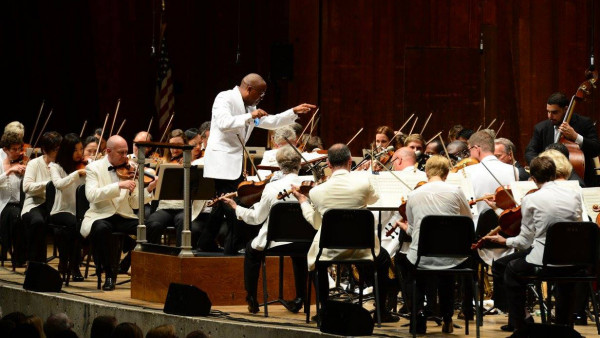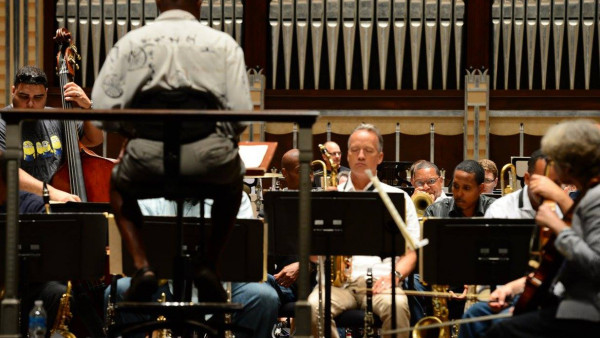Wynton Marsalis and Jazz at Lincoln Center Orchestra pack the house, and the ears
The second of two area concerts by the Jazz at Lincoln Center Orchestra with Wynton Marsalis was a hybrid affair, with a rather brief intermission separating a tribute to Duke Ellington by JLCO’s 16 players and a performance by the combined forces of the JLCO and the Cleveland Orchestra, led by William Eddins, of Marsalis’ “Swing Symphony.” The result was certainly a feast of music, even if there was more of it than an audience could digest at a single setting.
Saturday night’s venue was the Blossom Music Center (the Friday night concert was at Severance Hall). Both pavilion and lawn were packed with enthusiasts who’d come to hear the famous ensemble demonstrate its superlative skill in the context of jazz history that is the trademark of the Jazz at Lincoln Center programs. On the first half of the program, they were not disappointed.
The JLCO’s Ellington tribute brought to the fore some lesser known Ellington items from “The Mooche,” a 1928 showcase for trumpeter Bubber Miley, to “Amad” from the 1963 Ellington-Strayhorn “Far East Suite,” written for a State Department- sponsored tour of the Middle East.
Marsalis provided spoken “liner notes” between selections and made sure the ensemble’s soloists received the acclaim they deserved. His introduction to the 1938 Ellington rave-up “Braggin’ in Brass” — “If you can play this,” Marsalis said, “you’ve earned the right to brag” — featured a wonderful solo by trumpeter Marcus Printup, while the 1940 “Concerto for Cootie” allowed trumpeter Ryan Kiser the opportunity to both channel the soul of trumpeter Cootie Williams and to demonstrate the depth of his own musical imagination as he growled, wah-wah’d and shone with clarion brilliance.
Other highlights included Vincent Gardner’s sinuous solo on the aforementioned “Amad,” and a long and lovely solo by tenor sax man Walter Blanding, a Cleveland native, in the last movement, “Ready, Go,” of the playfully titled “Toot Suite,” from 1959.
Blanding was remarkably supple and fluid, with effortless flurries of notes and a tone that ranged from soft and sweet to bold and brassy.
The most interesting piece on the first half was “Portrait of Wellman Braud,” from Ellington’s “New Orleans Suite.” Contrapuntally complex and timbrally rich, “Portrait” is a tribute to Ellington’s first bassist, who also was a great-uncle to Marsalis. Saturday night, bassist Carlos Henriquez played the requisite solo with force and penetrative power.
The second half of the program was devoted to a single work, Marsalis’ “Swing Symphony,” which is his third essay in the symphonic form. (His “Blues Symphony was premiered in its entirety earlier this year.)
Cast in six discursive movements with a coda described as a finale, the work is more of a symphonic suite for the LCJO and a full symphonic orchestra, didactically describing in rigorous chronology the evolution of swing from its inception in New Orleans and Kansas City through its ultimate forms found in Third Stream jazz, post-bop and even (as hinted in the finale) modern funk.
While the individual movements are teeming with brilliant passages and inspired orchestration, the symphony suffers from a couple of problems that plague such efforts, the greatest of which is its length. Billed as a one-hour work, the “Swing Symphony” lasted nearly an hour and twenty minutes, a length more often encountered in a Mahler symphony. Reducing the number of sections from seven to, say, four more integrally developed musical paragraphs would organize the work into a more tightly argued essay.
Still, there were outstanding moments, especially in the third “Kansas City” movement, when the Cleveland Orchestra’s percussion section provided an exceptionally powerful and complex group cadenza that nearly stole the show.
An unannounced encore gave alto saxophonist Sherman Irby the opportunity to demonstrate a beautiful sense of melody and shape. Marsalis, who both figuratively and literally kept a low profile during the concert (he played from the back row with the rest of the trumpets), here had his first real solo of the evening, which the audience deemed well worth waiting for.
by Mark Satola
Source: Cleveland.com


